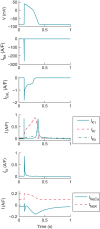Human-based approaches to pharmacology and cardiology: an interdisciplinary and intersectorial workshop
- PMID: 26622055
- PMCID: PMC5006958
- DOI: 10.1093/europace/euv320
Human-based approaches to pharmacology and cardiology: an interdisciplinary and intersectorial workshop
Abstract
Both biomedical research and clinical practice rely on complex datasets for the physiological and genetic characterization of human hearts in health and disease. Given the complexity and variety of approaches and recordings, there is now growing recognition of the need to embed computational methods in cardiovascular medicine and science for analysis, integration and prediction. This paper describes a Workshop on Computational Cardiovascular Science that created an international, interdisciplinary and inter-sectorial forum to define the next steps for a human-based approach to disease supported by computational methodologies. The main ideas highlighted were (i) a shift towards human-based methodologies, spurred by advances in new in silico, in vivo, in vitro, and ex vivo techniques and the increasing acknowledgement of the limitations of animal models. (ii) Computational approaches complement, expand, bridge, and integrate in vitro, in vivo, and ex vivo experimental and clinical data and methods, and as such they are an integral part of human-based methodologies in pharmacology and medicine. (iii) The effective implementation of multi- and interdisciplinary approaches, teams, and training combining and integrating computational methods with experimental and clinical approaches across academia, industry, and healthcare settings is a priority. (iv) The human-based cross-disciplinary approach requires experts in specific methodologies and domains, who also have the capacity to communicate and collaborate across disciplines and cross-sector environments. (v) This new translational domain for human-based cardiology and pharmacology requires new partnerships supported financially and institutionally across sectors. Institutional, organizational, and social barriers must be identified, understood and overcome in each specific setting.
Keywords: Arrhythmias; Biomarkers; Computational approaches; Computer modelling and simulations; Human electrophysiology; Human-based methods; Stem-cell-derived cardiomyocytes.
© The Author 2015. Published by Oxford University Press on behalf of the European Society of Cardiology.
Figures





Similar articles
-
Macromolecular crowding: chemistry and physics meet biology (Ascona, Switzerland, 10-14 June 2012).Phys Biol. 2013 Aug;10(4):040301. doi: 10.1088/1478-3975/10/4/040301. Epub 2013 Aug 2. Phys Biol. 2013. PMID: 23912807
-
Molecular cardiology in translation: gene, cell and chemical-based experimental therapeutics for the failing heart.J Cardiovasc Transl Res. 2008 Dec;1(4):317-27. doi: 10.1007/s12265-008-9065-6. J Cardiovasc Transl Res. 2008. PMID: 19956787 Free PMC article. Review.
-
Cardiac Immunotherapy, Immuno-Cardiology, and the Future of Cardiovascular Pharmacology.J Cardiovasc Pharmacol. 2025 May 1;85(5):308-311. doi: 10.1097/FJC.0000000000001687. J Cardiovasc Pharmacol. 2025. PMID: 40014789 Review.
-
The Integrative Sport of Cardiac Imaging and Clinical Cardiology: Machine Augmentation and an Evolving Odyssey.JACC Cardiovasc Imaging. 2024 Jul;17(7):792-794. doi: 10.1016/j.jcmg.2024.02.012. Epub 2024 Apr 10. JACC Cardiovasc Imaging. 2024. PMID: 38613557 No abstract available.
-
Novel targets and future strategies for acute cardioprotection: Position Paper of the European Society of Cardiology Working Group on Cellular Biology of the Heart.Cardiovasc Res. 2017 May 1;113(6):564-585. doi: 10.1093/cvr/cvx049. Cardiovasc Res. 2017. PMID: 28453734 Review.
Cited by
-
Computational techniques for ECG analysis and interpretation in light of their contribution to medical advances.J R Soc Interface. 2018 Jan;15(138):20170821. doi: 10.1098/rsif.2017.0821. J R Soc Interface. 2018. PMID: 29321268 Free PMC article. Review.
-
Dual Transcriptomic and Molecular Machine Learning Predicts all Major Clinical Forms of Drug Cardiotoxicity.Front Pharmacol. 2020 May 21;11:639. doi: 10.3389/fphar.2020.00639. eCollection 2020. Front Pharmacol. 2020. PMID: 32508633 Free PMC article.
-
What determines the optimal pharmacological treatment of atrial fibrillation? Insights from in silico trials in 800 virtual atria.J Physiol. 2023 Sep;601(18):4013-4032. doi: 10.1113/JP284730. Epub 2023 Jul 20. J Physiol. 2023. PMID: 37475475 Free PMC article.
-
Integrating cardiomyocytes from human pluripotent stem cells in safety pharmacology: has the time come?Br J Pharmacol. 2017 Nov;174(21):3749-3765. doi: 10.1111/bph.13577. Epub 2016 Sep 20. Br J Pharmacol. 2017. PMID: 27641943 Free PMC article. Review.
-
Feasibility of Using Adjunctive Optogenetic Technologies in Cardiomyocyte Phenotyping - from the Single Cell to the Whole Heart.Curr Pharm Biotechnol. 2020;21(9):752-764. doi: 10.2174/1389201020666190405182251. Curr Pharm Biotechnol. 2020. PMID: 30961485 Free PMC article. Review.
References
-
- Ewart L, Aylott M, Deurinck M, Engwall M, Gallacher DJ, Geys H et al. . The concordance between nonclinical and phase I clinical cardiovascular assessment from a cross-company data sharing initiative. Toxicol Sci 2014;142:427–35. - PubMed
-
- Koerner J, Valentin JP, Willard J, Park EJ, Bi D, Link WT et al. . Predictivity of non-clinical repolarization assay data for clinical TQT data in the FDA database. Int J Toxicol 2013;32:63.
-
- Severi S, Rodriguez B, Zaza A. Computational cardiac electrophysiology is moving towards translation medicine. Europace 2014;16:703–4. - PubMed
-
- Severi S, Rodriguez B, Zaza A. Computational cardiac electrophysiology is ready for prime time. Europace 2014;16:382–3. - PubMed
Publication types
MeSH terms
Substances
Grants and funding
LinkOut - more resources
Full Text Sources
Other Literature Sources
Medical

